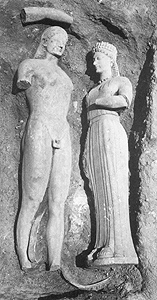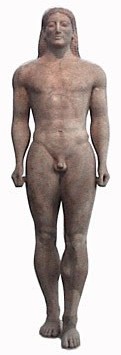
 kouros and kore
kouros and kore
archaic greece
sculpture
THE STATUES
The kouri and korae are statues a bit older than what we all know as 'classic' ancient greek period of sculpture.
Their main characteristic is their famous archaic smile (wikipedia). The classic statues do not smile :)
Lots of them were found carefully buried. The greeks buried their old statues, to make new ones.

-
- THE GREEK WORDS
-
KOYPOΣ gre.noun.masc. gre.pronunc: [ˈkuros]
plural: KOYPOI mod.gre.pronunc: ['kuri']
literally = young man
statue: young nude man’s archaic statue. He has no beard.
- KOPH gre.n.fem. early archaic script with koppa. gre.pronunc.erasmic ['korε]
 mod.gre.pronunc: [ˈkori]
mod.gre.pronunc: [ˈkori]
plural: anc.gre: KOPAI mod.gre: KOPEΣ
literally = daughter
statue: young dressed woman’s archaic statue
-
- LINKS
- http://www.fhw.gr/chronos/04/en/culture/322arts_sculp_kouroi_evol.html
- Foundation of Hellenic World (FHW) page: http://www.fhw.gr/chronos/04/en/culture/320arts_sculpture_intro.html
- Kouri by wikipedia
- Photos of many many kouri and korae at cobalt.rocky.edu/~moakm/
links checked in 2007./2017.



 kouros and kore
kouros and kore

 [photo] This kore in not from the Acropolis.
[photo] This kore in not from the Acropolis.